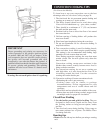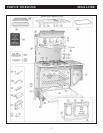heat up. At the Convection/Bake setting, the lower element
will be in use. Rack positions number from 1 at the bottom
to 5 at the top.
Convection Baking and Roasting
Your convection oven utilizes precise, consistent
temperature control to ensure absolutely even baking and
roasting results. In particular, foods that require browning
are greatly enhanced by the hot air convection cooking
method. Depending on the quantities you wish to prepare,
convection cooked foods can be positioned on single or
multiple racks. When roasting whole poultry or large cuts of
meat, you can effectively lower oven temperature settings,
and substantially reduce cooking times. You will notice the
remarkable difference in convection cooked foods.
Memorable Meats
Convection cooking techniques contribute special appeal
to your meat dishes by locking in flavour and retaining
moisture. The result is meat that is evenly browned outside
and tender and naturally juicy inside.
Before roasting or broiling, brush the entire surface of lean
meats with butter or oil. This will increase moisture retention
and enhance browning. Position cuts of meat, uncovered,
on the raised convection roasting rack, so that heat freely
reaches all sides.
Convection oven methods can conveniently reduce the
length of time required to roast meats, in comparison to
conventional roasting. Therefore, meat should be checked
shortly before the end of recommended cooking times, to
avoid over-cooking.
Insert an accurate meat thermometer into the thickest part of
the meat, taking care to avoid any bone, fat or gristle. Once
the desired internal temperature is reached, remove the meat
from the oven and let stand for a few minutes. This allows
the juices to settle for easier carving.
Convection Broiling
Convection broiling is essentially high-temperature
convection cooking, combining fan-circulated hot air with
the direct heat of the broiler element. We recommend
preheating your oven first to maintain an even temperature
during cooking. Convection broiling times will depend
upon the variable temperature selected and the rack position
used. Do not cover the broiling rack with tin foil as this will
block air flow and extend cooking time. The oven door must
remain closed while convection broiling. Circulating air
creates a seal on all sides of the food so that turning foods is
often not necessary.
Bakeware Selection
Bakeware with lower sides allows for constant air circulation
around all surface areas of food, for more even cooking. High-
sided casserole dishes and bread pans should be positioned
on the lower racks in the oven where they will benefit from
optimal heat distribution. For the most appetizing browning
results, use matte or dull finish metal pans as they conduct heat
more efficiently. Dark finishes on bakeware will absorb more
heat than reflective surfaces, resulting in darker, crispy bottom
crusts more suitable for pies and breads. Shiny muffin tins,
cake pans and cookie sheets tend to reflect heat, producing
light, tender crusts. Glass, ceramic, and stainless steel dishes
may not transmit heat as evenly as metal bakeware.
Perfect Poultry
Preheating your oven to cook poultry is often not necessary,
but we do suggest that you consult your individual recipes
first. As you will notice in the Convection Poultry Roasting
Chart, convection roasting temperatures are generally 25°F
(15°C) lower than those used in conventional ovens.
Poultry is completely cooked when an accurate meat
thermometer, inserted at the thickest part of the breast or
inner thigh, registers 185°F (85°C). The juices will run clear
and the meat should pull easily away from the bone.
Glazes or sauces may be brushed onto poultry during the last
half of cooking time, for the perfect finishing touch.
Delicate Fish & Seafood
A limitless variety of fish and seafood can be elegantly
prepared using different convection cooking methods.
Variable Convection/Broil temperature settings offer you
greater diversity compared to conventional broiling.
Before Convection/Broiling we recommend that you baste
all surface areas of your fish and seafood with oil or butter.
Reduce your oven temperature for broiling thin fillets, and
use a higher setting for broiling thicker fish steaks. Lower
temperatures may require longer cooking times, but thorough
hot air circulation eliminates the need to handle or turn
fragile fish during convection cooking.
Testing fish and seafood during the last few minutes of
recommended cooking time will ensure flawless results
without over-cooking. When the fish is opaque and flakes
easily, remove from the oven and serve.
Savory Vegetables & Side Dishes
Oven-baking your vegetables is no longer limited
to potatoes! Take full advantage of multi-level cooking
and simultaneously prepare appetizing, piping hot
accompaniments to your main meal with no cross-over
flavors. Continuous heat distribution throughout your
convection oven offers you the opportunity to efficiently
prepare a variety of side dishes and vegetables.
As you prepare your own favorites, remember that more
dense rice and pasta casseroles may require longer cooking
times. To allow for thoroughly cooked centers without over-
browned outside edges, lower oven temperatures at least
25°F (15°C), but not lower than 300°F (145°C).
30


















